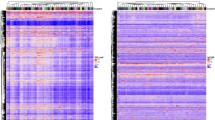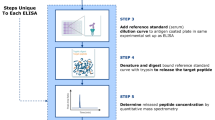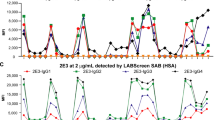Key Points
-
Autoantibody measurement is required for the adequate diagnosis and management of systemic autoimmune rheumatic diseases
-
The advent of new techniques, as well as the increasing number of autoimmune diagnostic laboratories, raises the issues of assay variability and reproducibility
-
As a consequence, harmonization of the available assays is becoming increasingly urgent
-
The availability of suitable reference material for calibration and quality control is emerging as a valuable tool for increasing assay reliability
-
Initiatives for harmonization of testing have been started by several international committees and organizations
Abstract
Autoantibody measurement is an excellent tool to confirm the diagnosis of rheumatic autoimmune diseases. Hence, reliability and harmonization of autoantibody testing are essential, but these issues are still a matter of debate. Intrinsic variability in analytes and reagents as well as heterogeneity of the techniques are the main reasons for discrepancies in inter-laboratory variations and reporting of test results. This lack of reliability might be responsible for wrong or missed diagnoses, as well as additional costs due to assay repetition, unnecessary use of confirmatory tests and/or consequent diagnostic investigations. To overcome such issues, the standardization of autoantibody testing requires efforts on all aspects of the assays, including the definition of the analyte, the pre-analytical stages, the calibration method and the reporting of results. As part of such efforts, the availability of suitable reference materials for calibration and quality control would enable the development of a reliable reference system. Strong-positive sera from patients have been used as reference materials in most of the autoantibody assays for rheumatic diseases; however, antigen-affinity-purified immunoglobulin fractions or in some cases reliable monoclonal antibody preparations offer more adequate tools for standardization. Systematic assessments of reference materials are currently underway, and preliminary results appear to be encouraging.
This is a preview of subscription content, access via your institution
Access options
Subscribe to this journal
Receive 12 print issues and online access
$209.00 per year
only $17.42 per issue
Buy this article
- Purchase on Springer Link
- Instant access to full article PDF
Prices may be subject to local taxes which are calculated during checkout
Similar content being viewed by others
References
Sen, D. & Brasington, R. Tight disease control in early RA. Rheum. Dis. Clin. North Am. 38, 327–343 (2012).
Ghirardello, A. et al. Diagnostic accuracy of currently available anti-double-stranded DNA antibody assays. An Italian multicentre study. Clin. Exp. Rheumatol. 29, 50–56 (2011).
van Venrooij, W. J., van Beers, J. J. & Pruijn, G. J. Anti-CCP antibodies: the past, the present and the future. Nat. Rev. Rheumatol. 7, 391–398 (2011).
Silva, F., Hummel, A. M., Jenne, D. E. & Specks, U. Discrimination and variable impact of ANCA binding to different surface epitopes on proteinase 3, the Wegener's autoantigen. J. Autoimmun. 35, 299–308 (2010).
Sun, J. et al. Capture-ELISA based on recombinant PR3 is sensitive for PR3-ANCA testing and allows detection of PR3 and PR3-ANCA/PR3 immune complexes. J. Immunol. Methods 1, 111–123 (1998).
Galli, M., Luciani, D., Bertolini, G. & Barbui, T. Anti-β2-glycoprotein I, antiprothrombin antibodies, and the risk of thrombosis in the antiphospholipid syndrome. Blood 102, 2717–2723 (2003).
Pregnolato, F. & Chighizola, C. in Autoantibodies 3rd edn (eds Shoenfeld, Y., Gershwin, M. E. & Meroni, P. L.) Ch. 88 (Elsevier, in press).
Mahler, M. & Fritzler, M. J. Epitope specificity and significance in systemic autoimmune diseases. Ann. NY Acad. Sci. 1183, 267–287 (2010).
de Laat, B. et al. Immune responses against domain I of β2-glycoprotein I are driven by conformational changes: domain I of β2-glycoprotein I harbors a cryptic immunogenic epitope. Arthritis Rheum. 63, 3960–3968 (2011).
Wolin, S. L. & Reinisch, K. M. The Ro 60 kDa autoantigen comes into focus: interpreting epitope mapping experiments on the basis of structure. Autoimmun. Rev. 5, 367–372 (2006).
Autoantibody Standardization Committee. AutoAb.org [online], (2012).
European Autoimmunity Standardisation Initiative. EASI Network [online], (2013).
Harmonisation of Autoantibody Tests (WG-HAT). International Federation of Clinical Chemistry and Laboratory Medicine [online], (2013).
United Kingdom National External Quality Assessment Service. UK NEQAS [online], (2013).
Vesper, H. W. et al. Characterisation and qualification of commutable reference materials for laboratory medicine: approved guideline. CLSI Document C53-A Vol. 30–12 Wayne (PA): CLSI, 2010.
Schimmel, H., Zegers, I. & Emons, H. Standardization of protein biomarker measurements: is it feasible? Scand. J. Clin. Lab. Invest. Suppl. 242, 27–33 (2010).
Nelson, P. N. et al. Monoclonal antibodies. J. Clin. Pathol. Mol. Pathol. 53, 111–117 (2000).
Bernareggi, D., Canevari, S. & Figini, M. in Autoantibodies 3rd edn (eds Shoenfeld, Y., Gershwin, M. E. & Meroni, P. L.) Ch. 10 (Elsevier, in press).
Ando, T. & Davies, T. F. Monoclonal antibodies to the thyrotropin receptor. Clin. Develop. Immunol. 12, 137–143 (2005).
Mendlovic, S. et al. Induction of a systemic lupus erythematosus-like disease in mice by a common human anti-DNA idiotype. Proc. Natl Acad. Sci. USA 85, 2260–2264 (1988).
Zhu, M. et al. Characterization of IgG monoclonal anti-cardiolipin/anti2GP1 antibodies from two patients with the anti-phospholipid syndrome reveals three species of antibodies. Br. J. Haematol. 105, 102 (1999).
Pierangeli, S. S. et al. Functional analyses of patient-derived IgG monoclonal anticardiolipin antibodies using in vivo thrombosis and in vivo microcirculation models. Thromb. Haemost. 84, 388–395 (2000).
Dienava-Verdoold, I. et al. Patient-derived monoclonal antibodies directed towards β2 glycoprotein-1 display lupus anticoagulant activity. J. Thromb. Haemost. 9, 738–747 (2011).
Miyakis, S. et al. International consensus statement on an update of the classification criteria for definite antiphospholipid syndrome (APS). J. Thromb. Haemost. 4, 295–306 (2006).
Meroni, P. L., Borghi, M. O., Raschi, E. & Tedesco, F. Pathogenesis of antiphospholipid syndrome: understanding the antibodies. Nat. Rev. Rheumatol. 7, 330–339 (2011).
Pengo, V. et al. Incidence of a first thromboembolic event in asymptomatic carriers of high-risk antiphospholipid antibody profile: a multicenter prospective study. Blood 118, 4714–4718 (2011).
Reber, G. et al. Variability of anti-β2 glycoprotein I antibodies measurement by commercial assays. Thromb. Haemost. 94, 665–672 (2005).
Pierangeli, S. S. et al. Standards and reference materials for the anticardiolipin and anti-β2 glycoprotein I assays: A report of recommendations from the APL TaskForce at the 13th International Congress on Antiphospholipid Antibodies. Clin. Chim. Acta 413, 358–360 (2012).
Lakos, G. et al. International consensus guidelines on anticardiolipin and anti-β2 glycoprotein I testing: Report from the 13th International Congress on Antiphospholipid Antibodies. Arthritis Rheum. 64, 1–10 (2012).
Erkan, D., Espinosa, G. & Cervera, R. Catastrophic antiphospholipid syndrome: updated diagnostic algorithms. Autoimmun. Rev. 10, 74–79 (2010).
Cervera, R., Conti, F., Doria, A., Iaccarino, L. & Valesini, G. Does seronegative antiphospholipid syndrome really exist? Autoimmun. Rev. 11, 581–584 (2012).
Tincani, A. et al. Minimal requirements for antiphospholipid antibodies ELISAs proposed by the European Forum on antiphospholipid antibodies. Thromb. Res. 114, 553–558 (2004).
Andreoli, L., Rizzini, S., Allegri, F., Meroni, P. L. & Tincani, A. Are the current attempts at standardization of antiphospholipid antibodies still useful? Emerging technologies signal a shift in direction. Semin. Thromb. Hemost. 34, 356–360 (2008).
Willis, R. et al. Establishment of standardized international units for IgG anti-β2glycoprotein antibody measurement [abstract 2455]. Arthritis Rheum. 64, S1033 (2012).
Schellekens, G. A. et al. Citrulline is an essential constituent of antigenic determinants recognized by rheumatoid arthritis-specific autoantibodies. J. Clin. Invest. 101, 273–281 (1998).
Suzuki, K. et al. High diagnostic performance of ELISA detection of antibodies to citrullinated antigens in rheumatoid arthritis. Scand. J. Rheumatol. 32, 197–204 (2003).
Kamoun, M. Diagnostic performance and predictive value of anti-citrullinated peptide antibodies for diagnosis of rheumatoid arthritis: Toward more accurate detection? Clin. Chem. 51, 12–13 (2005).
van Gaalen, F. A. et al. Autoantibodies to cyclic citrullinated peptides predict progression to rheumatoid arthritis in patients with undifferentiated arthritis. Arthritis Rheum. 50, 709–715 (2004).
Kroot, E. et al. The prognostic value of the anti-cyclic citrullinated peptide antibody in patients with recent-onset rheumatoid arthritis. Arthritis Rheum. 43, 1831–1835 (2000).
Avouac, J., Gossec, L. & Dougados, M. Diagnostic and predictive value of anti-cyclic citrullinated protein antibodies in rheumatoid arthritis: a systematic literature review. Ann. Rheum. Dis. 65, 845–851 (2006).
van der Helm-van Mil, A. H. M. et al. Antibodies to citrullinated proteins and differences in clinical progression of rheumatoid arthritis. Arthritis Res. Ther. 7, R949–R958 (2005).
Meyer, O. et al. Anticitrullinated protein/peptide antibody assays in early rheumatoid arthritis for predicting five year radiographic damage. Ann. Rheum. Dis. 62, 120–126 (2003).
Kastbom, A. et al. Anti-CCP antibody test predicts the disease course during three years in early rheumatoid arthritis (the TIRA project). Ann. Rheum. Dis. 63, 1085–1089 (2004).
Chan, M. T. et al. Anti-cyclic citrullinated peptide antibodies are associated with erosive arthritis in SLE. Arthritis Rheum. 52, S611 (2005).
Forslind, K. et al. Prediction of radiological outcome in early RA in clinical practice: role of antibodies to citrullinated peptides (anti-CCP). Ann. Rheum. Dis. 63, 1090–1095 (2004).
Rantapää-Dahlqvist, S. et al. Antibodies against cyclic citrullinated peptide and IgA rheumatoid factor predict the development of rheumatoid arthritis. Arthritis Rheum. 48, 2741–2749 (2003).
Nielen, M. M. et al. Specific autoantibodies precede the symptoms of rheumatoid arthritis: a study of serial measurements in blood donors. Arthritis Rheum. 50, 380–386 (2004).
Nell, V. et al. Benefit of very early referral and very early therapy with disease-modifying anti-rheumatic drugs in patients with early rheumatoid arthritis. Rheumatology 43, 906–914 (2004).
Aletaha, D. et al. Rheumatoid arthritis classification criteria: an American College of Rheumatology/European League Against Rheumatism collaborative initiative. Arthritis Rheum. 62, 2569–2581 (2010).
Bizzaro, N. et al. Analytical and diagnostic characteristics of 11 2nd- and 3rd-generation immunoenzymatic methods for the detection of antibodies to citrullinated proteins. Clin. Chem. 53, 1527–1533 (2007).
Bizzaro, N. et al. Preliminary evaluation of the first international reference preparation for anticitrullinated peptide antibodies. Ann. Rheum. Dis. 71, 1388–1392 (2012).
Fritzler, M. J. & Fritzler, M. L. The emergence of multiplexed technologies as diagnostic platforms in systemic autoimmune diseases. Curr. Med. Chem. 13, 2503–2512 (2006).
Hanly, J. G., Su, L., Farewell, V. & Fritzler, M. J. Comparison between multiplex assays for autoantibody detection in systemic lupus erythematosus. J. Immunol. Methods 30, 75–80 (2010).
Wiik, A. S., Høier-Madsen, M., Forslid, J., Charles, P. & Meyrowitsch, J. Antinuclear antibodies: A contemporary nomenclature using HEp-2 cells. J. Autoimmun. 35, 276–290 (2010).
Solomon, D. H. et al. Evidence-based guidelines for the use of immunologic testing: ANA. Arthritis Rheum. 47, 434–444 (2002).
Meroni, P. L. & Schur, P. H. ANA screening: an old test with new recommendations. Ann. Rheum. Dis. 69, 1420–1422 (2010).
Hochberg, M. C. Updating the American College of Rheumatology revised criteria for the classification of systemic lupus erythematosus. Arthritis Rheum. 40, 1725 (1997).
LeRoy, E. C. et al. Scleroderma (systemic sclerosis): classification, subsets and pathogenesis. J. Rheumatol. 15, 202–205 (1988).
Shiboski, S. C. et al. American College of Rheumatology classification criteria for Sjögren's syndrome: a data-driven, expert consensus approach in the Sjögren's International Collaborative Clinical Alliance cohort. Arthritis Care Res. (Hoboken) 64, 475–487 (2012).
Amigues, J. M., Cantagrel, A., Abbal, M. & Mazieres, B. Comparative study of 4 diagnosis criteria sets for mixed connective tissue disease in patients with anti-RNP antibodies. Autoimmunity Group of the Hospitals of Toulouse. J. Rheumatol. 23, 2055–2062 (1996).
Mosca, M., Neri, R. & Bombardieri, S. Undifferentiated connective tissue diseases (UCTD): a review of the literature and a proposal for preliminary classification criteria. Clin. Exp. Rheumatol. 17, 615–620 (1999).
Watts, R. et al. Development and validation of a consensus methodology for the classification of the ANCA-associated vasculitides and polyarteritis nodosa for epidemiological studies. Ann. Rheum. Dis. 66, 222–227 (2007).
Nihtyanova, S. I. & Denton, C. P. Autoantibodies as predictive tools in systemic sclerosis. Nat. Rev. Rheumatol. 6, 112–116 (2010).
Hirschfield, G. M. Diagnosis of primary biliary cirrhosis. Best Pract. Res. Clin. Gastroenterol. 25, 701–712 (2011).
Munoz, L. E., Gaipl, U. S. & Herrmann, M. Predictive value of anti-dsDNA autoantibodies: importance of the assay. Autoimmun. Rev. 7, 594–597 (2008).
Oke, V. & Wahren-Herlenius, M. The immunobiology of Ro52 (TRIM21) in autoimmunity: a critical review. J. Autoimmun. 39, 77–82 (2012).
Mimori, T., Imura, Y., Nakashima, R. & Yoshifuji, H. Autoantibodies in idiopathic inflammatory myopathy: an update on clinical and pathophysiological significance. Curr. Opin. Rheumatol. 19, 523–529 (2007).
Hanley, J. G. et al. Autoantibodies and neuropsychiatric events at the time of systemic lupus erythematosus diagnosis. Arthritis Rheum. 58, 843–853 (2008).
Katz, U. & Zandman-Goddard, G. Drug-induced lupus: an update. Autoimmun. Rev. 10, 46–50 (2010).
Gomez-Puerta, J. A., Burlingame, R. W. & Cervera, R. Anti-chromatin (anti-nucleosome) antibodies: diagnostic and clinical value. Autoimmun. Rev. 7, 606–611 (2008).
Pickering, M. C. & Botto, M. Are anti-C1q antibodies different from other SLE autoantibodies? Nat. Rev. Rheumatol. 6, 490–493 (2010).
Willemze, A., Trouw, L. A., Toes, R. E. & Huizinga, T. W. The influence of ACPA status and characteristics on the course of RA. Nat. Rev. Rheumatol. 8, 144–152 (2012).
Sanmarco, M. & Bardin, N. The contribution of antiphosphatidylethanolamine antibodies in the diagnosis of the antiphospholipid syndrome. Lupus 21, 727–728 (2012).
Urbanus, R. T. & de Laat, B. Antiphospholipid antibodies and the protein C pathway. Lupus 19, 394–399 (2010).
Galli, M. Non β2-glycoprotein I cofactors for antiphospholipid antibodies. Lupus 5, 388–392 (1996).
Szodoray, P. et al. Identification of rare anti-phospholipid/protein co-factor autoantibodies in patients with systemic lupus erythematosus. Autoimmunity 42, 497–506 (2009).
Acknowledgements
Silvia S. Pierangeli suddenly passed away last August during the revision of the present Review. All the authors do not forget her enthusiasm and great contribution and would like to dedicate the present paper to her memory.
Author information
Authors and Affiliations
Contributions
All authors made substantial contributions to writing the manuscript and reviewing/editing it before submission. In addition, P. L. Meroni, M. Biggioggero, J. Sheldon, I. Zegers and M. O. Borghi researched data for the article, and P. L. Meroni, S. S. Pierangeli, J. Sheldon, I. Zegers and M. O. Borghi made substantial contributions to discussions of article content.
Corresponding author
Ethics declarations
Competing interests
The authors declare no competing financial interests.
Rights and permissions
About this article
Cite this article
Meroni, P., Biggioggero, M., Pierangeli, S. et al. Standardization of autoantibody testing: a paradigm for serology in rheumatic diseases. Nat Rev Rheumatol 10, 35–43 (2014). https://doi.org/10.1038/nrrheum.2013.180
Published:
Issue Date:
DOI: https://doi.org/10.1038/nrrheum.2013.180
This article is cited by
-
A machine learning model identifies patients in need of autoimmune disease testing using electronic health records
Nature Communications (2023)
-
How to report the antinuclear antibodies (anti-cell antibodies) test on HEp-2 cells: guidelines from the ICAP initiative
Immunologic Research (2021)
-
Anti-phospholipid IgG antibodies detected by line immunoassay differentiate patients with anti-phospholipid syndrome and other autoimmune diseases
Autoimmunity Highlights (2018)
-
Diagnosing antiphospholipid syndrome: 'extra-criteria' manifestations and technical advances
Nature Reviews Rheumatology (2017)
-
The universe of ANA testing: a case for point-of-care ANA testing
Autoimmunity Highlights (2017)



